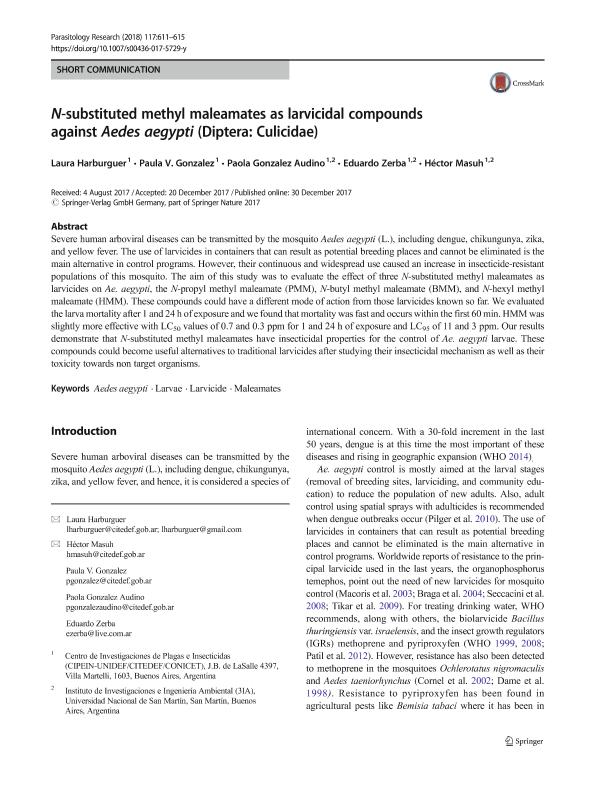Artículo
N-substituted methyl maleamates as larvicidal compounds against Aedes aegypti (Diptera: Culicidae)
Harburguer, Laura Vanesa ; Gonzalez, Paula Valeria
; Gonzalez, Paula Valeria ; Gonzalez Audino, Paola Andrea
; Gonzalez Audino, Paola Andrea ; Zerba, Eduardo Nicolás
; Zerba, Eduardo Nicolás ; Masuh, Hector Mario
; Masuh, Hector Mario
 ; Gonzalez, Paula Valeria
; Gonzalez, Paula Valeria ; Gonzalez Audino, Paola Andrea
; Gonzalez Audino, Paola Andrea ; Zerba, Eduardo Nicolás
; Zerba, Eduardo Nicolás ; Masuh, Hector Mario
; Masuh, Hector Mario
Fecha de publicación:
02/2018
Editorial:
Springer
Revista:
Parasitology Research
ISSN:
0932-0113
Idioma:
Inglés
Tipo de recurso:
Artículo publicado
Clasificación temática:
Resumen
Severe human arboviral diseases can be transmitted by the mosquito Aedes aegypti (L.), including dengue, chikungunya, zika, and yellow fever. The use of larvicides in containers that can result as potential breeding places and cannot be eliminated is the main alternative in control programs. However, their continuous and widespread use caused an increase in insecticide-resistant populations of this mosquito. The aim of this study was to evaluate the effect of three N-substituted methyl maleamates as larvicides on Ae. aegypti, the N-propyl methyl maleamate (PMM), N-butyl methyl maleamate (BMM), and N-hexyl methyl maleamate (HMM). These compounds could have a different mode of action from those larvicides known so far. We evaluated the larva mortality after 1 and 24 h of exposure and we found that mortality was fast and occurs within the first 60 min. HMM was slightly more effective with LC50 values of 0.7 and 0.3 ppm for 1 and 24 h of exposure and LC95 of 11 and 3 ppm. Our results demonstrate that N-substituted methyl maleamates have insecticidal properties for the control of Ae. aegypti larvae. These compounds could become useful alternatives to traditional larvicides after studying their insecticidal mechanism as well as their toxicity towards non target organisms.
Palabras clave:
Aedes Aegypti
,
Larvae
,
Larvicide
,
Maleamates
Archivos asociados
Licencia
Identificadores
Colecciones
Articulos(UNIDEF)
Articulos de UNIDAD DE INVESTIGACION Y DESARROLLO ESTRATEGICOS PARA LA DEFENSA
Articulos de UNIDAD DE INVESTIGACION Y DESARROLLO ESTRATEGICOS PARA LA DEFENSA
Citación
Harburguer, Laura Vanesa; Gonzalez, Paula Valeria; Gonzalez Audino, Paola Andrea; Zerba, Eduardo Nicolás; Masuh, Hector Mario; N-substituted methyl maleamates as larvicidal compounds against Aedes aegypti (Diptera: Culicidae); Springer; Parasitology Research; 117; 2; 2-2018; 611-615
Compartir
Altmétricas



